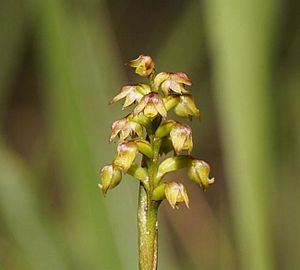Green midge orchid
Quick facts for kids Green midge orchid |
|
|---|---|
 |
|
| Genoplesium pumilum growing near Erowal Bay | |
| Scientific classification | |
| Genus: |
Genoplesium
|
| Species: |
pumilum
|
| Synonyms | |
|
|
The Genoplesium pumilum, often called the green midge orchid in Australia, and the yellow gumland leek orchid in New Zealand, is a tiny wild orchid. It grows naturally in south-eastern Australia and New Zealand. This orchid has one thin leaf that is joined to its flower stem. It can grow up to twenty-five small flowers. These flowers are usually green or yellowish-green and sometimes have red marks. In Australia and New Zealand, scientists also know this orchid as Corunastylis pumila.
Contents
What is the Green Midge Orchid Like?
The green midge orchid is a plant that lives for many years. It grows from a special underground part called a tuber, which is like a small storage root. Each plant has a single thin leaf. This leaf can be about 10 to 20 centimeters (4 to 8 inches) long. A small part of the leaf sticks out freely from the stem.
Flowers of the Green Midge Orchid
This orchid produces a cluster of five to twenty-five flowers. These flowers are green to yellowish-green and might have red spots. They grow on a stem that is about 1.5 to 2.5 centimeters (0.6 to 1 inch) tall. The flowers themselves are tiny, about 5 millimeters (0.2 inches) long. They often lean forward.
A cool fact about these flowers is that they are "inverted." This means their special lip-like petal, called the labellum, is on top instead of at the bottom. The labellum is thick and fleshy. It has tiny teeth along its edges. There is also a raised part, called a callus, in the middle of the labellum.
The green midge orchid blooms at different times depending on where it grows. In Australia, you can see its flowers between January and May. In New Zealand, it flowers from February to October.
How Was the Green Midge Orchid Named?
The green midge orchid was first officially described in 1853. A scientist named Joseph Dalton Hooker gave it the name Prasophyllum pumilum. Later, in 1989, two other scientists, David Jones and Mark Clements, changed its name to Genoplesium pumilum. Then, in 2002, they changed it again to Corunastylis pumila.
The word "pumilum" in its name comes from Latin. It means "dwarfish" or "little," which makes sense for such a small orchid!
Where Does the Green Midge Orchid Grow?
The green midge orchid likes to grow in wet places. You can find it in wet heathlands, areas called wallum, and along the edges of swamps.
In Tasmania, Australia, it grows on flat areas covered with a plant called buttongrass. In New Zealand, it lives in sparsely vegetated "gumland scrub" areas. In New South Wales, Australia, it is mostly found near the coast. In Victoria, it grows in the far east and on French Island. It is also common in coastal parts of Tasmania. In New Zealand, you can find it on the North and Chatham Islands.

